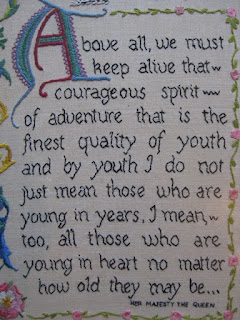Earlier this year on eBay this peace sampler was offered. It is patriotic rather than royal, commemorating the end of World War II for Britain - VE Day and VJ Day, both in 1945. The design features a lot of symmetry - the flags and searchlights; and balances different motifs representing the Allies in a pleasing way - the Eiffel Tower and the Statue of Liberty, the kangaroo facing the elephant. I particularly like the font on this. I do not know if it was a commercially-available design/transfer or the work of a single embroiderer (if the latter, she certainly had design ability as well as stitching skill). As the seller noted, if it was made when or soon after the war ended, materials to make it would likely have been in short supply. I find the searchlights particularly poignant as a reminder of the constant danger of wartime life for civilians as well as those in the services.
A couple of pictures showing it in more detail:
There are quite a few samplers commemorating the jubilees and coronations of the 1930s and 1950s, many if not most from commercial interests and sewn by many many embroiderers and needlewomen. I have seen fewer designs relating to World War II. Partly, no doubt, because the nation was busy elsewhere - pattern designers and newspaper columns and magazines (paper shortages, too). But there is a history of wartime needlework. In quilting, the famous quilt by Jane Stickle known through
Brenda Papadakis' Dear Jane book has, in the bottom corner of her immensely complex design (dozens and dozens of 4in blocks, all different), the evocative embroidered phrase, "In War-Time, 1863" - the US Civil War. During World War II, the women interned (in terrible conditions) by the Japanese at Changi made three quilts - including one for their Japanese captors - from embroidered signature squares. Read more about the Changi quilts
here and
here. Possibly the most poignant square is this one:
There are so many records of war - in words and images and stitches. These ones in stitches I find to have a particular and immediate impact. The hands that stitched them were there with the needle and thread, and the stitched words and images feel as individual and close as fingerprints, humans connecting over time.
I think that's why I find these British patriotic samplers and embroideries so compelling and interesting and engaging, that sense of a connection to another individual life. I wonder if, for some of these, the embroidered sampler is the only thing that survives of some of these people. Clothes and possessions can be dispersed, household chattels dispensed with: but the samplers have the testament of an individual's life, and a specific time in that individual's life when they committed themselves to the task of commemorating an event of importance to them. There's a sadness in that so few of these have a record (either stitched on the sampler or noted on the back of the frame etc) of the embroiderer's name. So they survive as testament to mind and heart, but to the mind and heart of someone anonymous. I have asked for provenance for some of those I've added to my collection, but nearly always they've come from a fair or clearance sale, not from a known household or person.
There's a curious quality to all these patriotic samplers, most particularly the royal ones - few if any of the embroiderers would ever have been likely to meet the monarchs whose jubilees and coronations they laboured for many hours and days to stitch and remember; and yet clearly they felt involved and connected, that these things were important enough to them to spend that time and create the artefact of their patriotism.
And if you look at the earlier blog entry about William and Kate's wedding, the patriotic sampler industry is alive and well and finding customers in 2011, as samplers and embroideries associated with Charles and Diana events did in the 1980s and 1990s.
As ever, if you know any more about the design/source of the peace sampler illustrated above, please do leave a comment.















